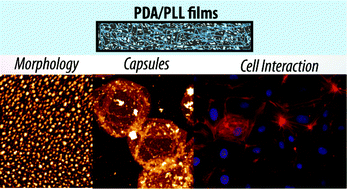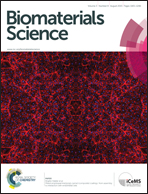Mixed poly(dopamine)/poly(l-lysine) (composite) coatings: from assembly to interaction with endothelial cells†
Abstract
Engineered polymer films are of significant importance in the field of biomedicine. Poly(dopamine) (PDA) is becoming more and more a key player in this context. Herein, we deposited mixed films consisting of PDA and poly(L-lysine) (PLL) of different molecular weights. The coatings were characterized by quartz crystal microbalance with dissipation monitoring, atomic force microscopy, and X-ray photoelectron spectroscopy. The protein adsorption to the mixed films was found to decrease with increasing amounts of PLL. PDA/PLL capsules were also successfully assembled. Higher PLL content in the membranes reduced their thickness while the ζ-potential increased. Further, endothelial cell adhesion and proliferation over 96 h were found to be independent of the type of coating. Using PDA/PLL in liposome-containing composite coatings showed that sequential deposition of the layers yielded higher liposome trapping compared to one-step adsorption except for negatively charged liposomes. Association/uptake of fluorescent cargo by adherent endothelial cells was found to be different for PDA and PDA/PLL films. Taken together, our findings illustrate the potential of PDA/PLL mixed films as coatings for biomedical applications.


 Please wait while we load your content...
Please wait while we load your content...